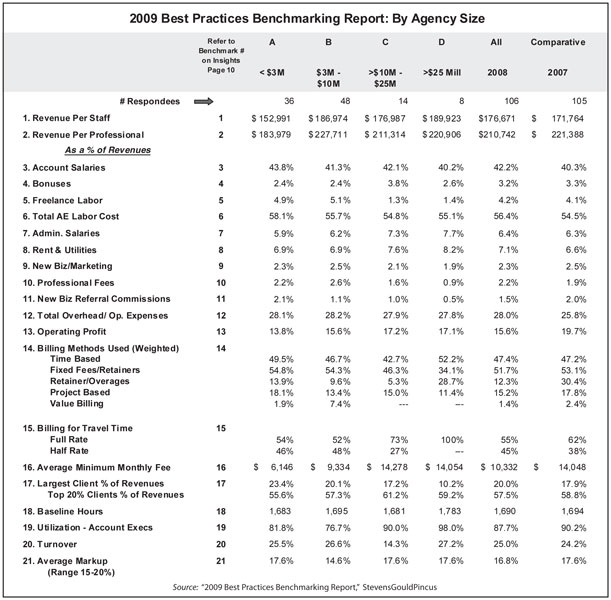As discussed in “Play to Win: Prove Your Worth (and Profit) as a Results-Oriented Agency” (see pages 1, 6), billing strategies are a key benchmark of an agency’s bottom-line success, but by no means is it the only benchmark. The 2009 Best Practices Benchmarking Report, released by StevensGouldPincus, identified the 21 most critical benchmarks for PR firms to track, keeping changing market forces in mind (see chart for 21 benchmarks by agency size).
In addition to comparing these benchmarks to 2008 and 2007 values, the report also put them in context by offering analysis and target numbers for agency leaders to aim for. Among the recommendations (as a percent of revenues):
• Account salaries: According to Rick Gould, partner at StevensGouldPincus, a good target percentage for account salaries is 35%, with this year’s value coming in a 42.2%.
• Total labor costs: Labor costs are up to 56.4% this year. “This is an indication [that] salaries, bonuses and freelance labor need to be managed more tightly. Model firms keep total labor costs as low as 50% and never in excess of 55%,” Gould says.
• Total operating costs/overhead (28%): “Our advice is always to consistently monitor these costs,” Gould says. “It is very difficult to change courses and cut back quickly during less prosperous times. Model firms will be sure this benchmark is below 25%.”
• Operating profit (15.6%): Down from 19.7% in last year’s report, this decline is consistent with the economic downturn.
• Average minimum monthly fee ($10,332): “The overall average for participating firms was significantly lower than a year ago,” Gould says. “This is a trend and shows that clients have been fee-resistant with the effects of the economic slowdown.”
• Baseline hours: This benchmark represents targeted client hours for an account staff person. According to Gould, 1,700 hours should be the goal for account executives doing client work exclusively, 500 for the CEO and 1,000 for a VP who does a significant amount of new business pitches and proposal writing. “Start with the total hours, back out the non-client time and get your baseline. You can then use this for budgeting billable hours, revenues for the month and year-end productivity metrics.”
• Account staff/utilization targets (87.7%): This represents the percentage of total hours that are actually billable (as opposed to write-offs). “This benchmark is critical to watch in order to realistically budget revenues,” Gould says. “The net utilization hours multiplied by the billing rate should equal the dollars generated by that staff person.” PRN
CONTACT:
Rick Gould, [email protected]
